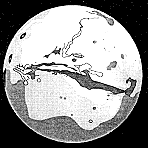
|
Feedback Form
Roaming on Mars
This activity was written by Greg Vogt of NASA's education department, Johnson Space Centre, Houston.
Context
The year is 2003. You are a member of a Mars Robotic Exploration Team. Two weeks ago, the NASA Pathfinder III spacecraft landed on Mars. Telemetry (radio data) from the spacecraft has indicated all systems on board are functioning perfectly. The mission director has approved the first remote investigation, which will commence tomorrow. The goal of this investigation is to look for water ice in the Martian soil.
Your team has to prepare a route map for the microrover laboratory which will depart the Pathfinder III, travel to five investigation sites, and return. The sites were determined by the science team to be locations likely to have ice deposits beneath the soil surface. The roving laboratory must visit each site and stop for 30 minutes to permit sampling tools to collect and store soil and ice samples (if present). The roving laboratory will have sufficient energy resources to operate for 5 hours.
Challenge
The science team has provided your team with a map showing the location of Pathfinder III on Mars and the five sites to be studied. Also provided are topographic data of the landscape. This information is essential because there are some areas too rough or too steep for the roving vehicle to safely travel through. It is your team's objective to plot a route for the microrover to follow that will permit it to visit each site, conduct its studies, and return to Pathfinder III within the time allowed.
To confirm the route plan, you will conduct a simulation using the Roamer robot. After plotting your route on the map, you will write a program for the Roamer permitting you to test the route. Then you will program the Roamer and run a sampling mission simulation on a model of the Martian surface. If your Roamer visits each site and returns to Pathfinder III within the time allowed, you will have successfully completed your mission.
Because you are doing a model study, you will be employing various scales for measurement. The map will have a scale of 1:10. This means that one centimetre on your map will equal 10 centimetres on the model. The model, however will have its own scale compared to the actual Martian surface. The scale will be 1:1000. This means that one centimetre on your model will equal 1000 centimetres (10 metres) on Mars. You will also use a 1:60 scale for time. One second of Roamer operating time on your model will equal one minute of microrover operation on Mars. You are limited to 5 hours of operating time on Mars. Therefore you are permitted only 5 minutes of operating time on your model.
Background Information
 Mars is a
small planet of about 6,800 kilometres in diameter. The gravity force
at the Martian surface is about 38 percent that at Earth's surface. A
70 kilogram person on Earth would weigh only 27 kilograms on Mars.
Mars is a
small planet of about 6,800 kilometres in diameter. The gravity force
at the Martian surface is about 38 percent that at Earth's surface. A
70 kilogram person on Earth would weigh only 27 kilograms on Mars.
Mars rotates on its axis every 24 hours and 37 minutes. Its axis is tilted like Earth's, causing the planet to have seasons. Because Mars is further from the sun that Earth and has a longer orbit, its seasons are almost twice as long as Earth's. The temperature at the surface ranges from a cold -133 degrees Celsius to a high of 27 degrees Celsius.
The atmosphere of Mars is very thin. The pressure is about the same that exists on Earth at an altitude of 37,000 meters (about 4 times higher than Mount Everest). Because of the very low pressure, about 125th that of Earth's atmosphere, liquid water cannot exist on Mars's surface. Previous spacecraft missions have detected ice in the Martian polar caps but none in the equatorial regions.
One of the important questions about Mars is what happened to Mars's water. The 1971 Mariner 9 mission to Mars photographed small channels on the Mars surface that look very much like water-cut channels on Earth. Later spacecraft also observed the channels. Scientists have speculated that Mars may have had a thicker atmosphere in its distant past. If so, Mars could have had lakes and oceans, rain and snow. Water runoff could easily have cut the channels. However, no spacecraft has discovered any of water ice being present in these locations. One of the objectives of the Pathfinder III mission is to try to find waterice on Mars and analyse any gas that might be frozen inside it. The gas would tell scientists what Mars's atmosphere was once like.
| Back |
|---|
